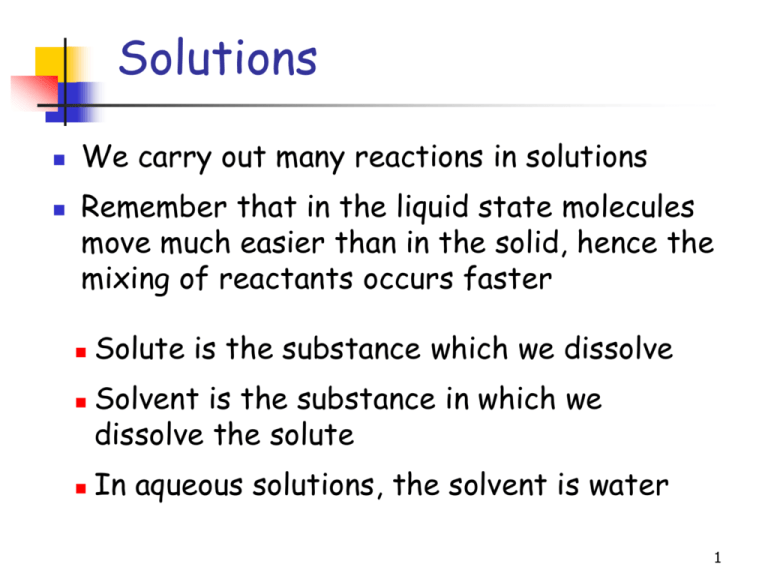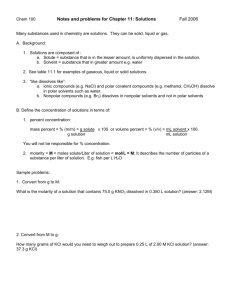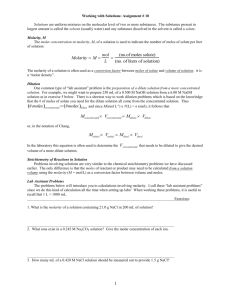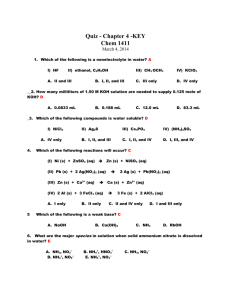Chapter One
advertisement

Solutions We carry out many reactions in solutions Remember that in the liquid state molecules move much easier than in the solid, hence the mixing of reactants occurs faster Solute is the substance which we dissolve Solvent is the substance in which we dissolve the solute In aqueous solutions, the solvent is water 1 Concentration of Solutions The concentration of a solution defines the amount of solute dissolved in the solvent We will express the concentration of a solution in one of the two most common ways: percent by mass molarity 2 Percent by mass of solute mass of solute % by mass of solute = 100% mass of solution mass of solution = mass of solute + mass of solvent What does it tell us? The mass of solute in 100 mass units of solution m(solute) ω(solute) = 100% m(solution ) usually expressed as “% w/w” 3 Example 1 What is the concentration of the solution obtained by dissolving 25 g of NaOH in 300.0 mL of water? 4 Example 2 What mass of NaOH is required to prepare 250.0 g of solution that is 8.00% w/w NaOH? m(NaOH) % by mass (NaOH) = 100% m(solution ) m(NaOH) 8.00% = 100% 250.0 g 250.0 g 8.00% m(NaOH) = 20.0 g 100% 5 Example 3 Calculate the mass of 8.00% w/w NaOH solution that contains 32.0 g of NaOH. m(NaOH) % by mass (NaOH) = 100% m(solution ) 32.0 g 8.00% = 100% m(solution ) 32.0 g 100% m(solution ) = 400. g 8.00% 6 Example 4 What volume of 12.0% KOH contains 40.0 g of KOH? The density of the solution is 1.11 g/mL. 7 Molarity, or Molar Concentration number of moles of solute molarity number of liters of solution n (solvent) mol mmol M or V (solution) L mL Always divide the number of moles of the solute by the volume of the solution, not by the volume of the solvent 8 Example 5 Calculate the molarity of a solution that contains 12.5 g of sulfuric acid in 1.75 L of solution. 9 Example 6 Determine the mass of calcium nitrate required to prepare 3.50 L of 0.800 M Ca(NO3)2. We first find the number of moles of Ca(NO3)2 dissolved in the solution: # moles (solute) M V (solution) # moles (Ca(NO3 )2 ) 0.800 mol/L 3.50 L # moles (Ca(NO3 )2 ) 0.800 mol/L 3.50 L 2.80 mol 10 Example 6 Now we calculate the molar mass of Ca(NO3)2 and find its mass in grams necessary for preparation of the solution: Mr (Ca(NO3 )2 ) 164.09 g/mol m(Ca(NO3 )2 ) Mr (Ca(NO3 )2 ) # moles (Ca(NO3 )2 ) m(Ca(NO3 )2 ) 164.09 g/mol 2.80 mol 459 g 11 Dilution of Solutions n (solute) M V (solution) n (solute) M V (solution) Solution 1: concentration = M1 volume = V1 We add more solvent (dilute the solution) concentration = M2 volume = V2 n M1 V1 n M2 V2 The amount of solute remains the same (we didn’t add any solute to the solution) 12 Dilution of Solutions M1 V1 M2 V2 If we know any 3 of these 4 quantities, we can calculate the other one The relationship is appropriate for dilutions but not for chemical reactions 13 Example 7 If 10.0 mL of 12.0 M HCl is added to enough water to give 100. mL of solution, what is the concentration of the solution? 14 Example 8 What volume of 18.0 M sulfuric acid is required to make 2.50 L of a 2.40 M sulfuric acid solution? V1 = ? M1 = 18.0 M V2 = 2.50 L M2 = 2.40 M V1 18.0 M = 2.50 L 2.40 M V1 = 0.333 L 15 Using Solutions in Chemical Reactions Combine the concepts of molarity and stoichiometry to determine the amounts of reactants and products involved in reactions in solution. 16 Example 9 What volume of 0.500 M BaCl2 is required to completely react with 4.32 g of Na2SO4? 17 Example 10 What volume of 0.200 M NaOH will react with 50.0 mL of 0.200 M aluminum nitrate, Al(NO3)3? What mass of Al(OH)3 will precipitate? 3NaOH + Al(NO3)3 3NaNO3 + Al(OH)3 First we calculate the number of moles of Al(NO3)3 (remember to convert mL to L): # moles(Al(N O3 )3 ) M (Al(NO3 )3 ) 0.200 mol/L 0.0500 L # moles(Al(N O3 )3 ) 0.0100 mol 18 Example 10 (continued) From the equation we see that each mole of Al(NO3)3 reacts with 3 moles of NaOH. Therefore, we multiply the number of moles of Al(NO3)3 by 3 to find the number of moles of NaOH required for the reaction: # moles (NaOH) = 0.0300 mol Now we again use the formula for the molarity to find the volume of the NaOH solution reacting: 0.0300 mol 0.200 mol/L V(solution ) V(solution) = 0.150 L = 150 mL 19 Example 10 (continued) Each mole of Al(NO3)3 produces 1 mole of Al(OH)3. Since the reacting solution contains 0.0100 mole of Al(NO3)3, 0.0100 mole of Al(OH)3 will be formed: m(Al(OH)3) = #moles(Al(OH)3) Mr(Al(OH)3) m(Al(OH)3) = 0.0100 mol 78.00 g/mol = 0.780 g 0.0300 mol 0.200 mol/L V(solution ) V(solution) = 0.150 L = 150 mL 20 Example 11 What is the molarity of a KOH solution if 38.7 mL of the KOH solution is required to react with 43.2 mL of 0.223 M HCl? KOH + HCl KCl + H2O First we calculate the number of moles of HCl in the solution (remember to convert mL to L): # moles(HCl) M (HCl) 0.223 mol/L 0.0432 L # moles(HCl) 9.63 10 3 mol 21 Example 11 (continued) KOH + HCl KCl + H2O From the equation we see that each mole of HCl reacts with 1 mole of KOH. Therefore, 9.63·10-3 mole of HCl will react with 9.63·10-3 mole of KOH. Now we can use the formula for the molarity: # moles(KOH) M (KOH) V(solution ) 9.63·10-3 mol M (KOH) 0.249 mol/L 0.249 M 0.0387 L 22 Example 12 What is the molarity of a barium hydroxide solution if 44.1 mL of 0.103 M HCl is required to react with 38.3 mL of the Ba(OH)2 solution? 23 Metals and Nonmetals Stair step function on periodic table separates metals from nonmetals. Metals are to the left of the stair step Nonmetals are to the right of the stair step 24 Metals and Nonmetals Periodic trends in metallic character More Metallic More Metallic Periodic Chart 25 Metals and Nonmetals Metals tend to form cations Nonmetals tend to form anions or oxoanions Li1+, Ca2+, Ni2+, Al3+ Cl1-, O2-, P3ClO41-, NO31-, CO32-, SO42-, PO43- Important exceptions: H1+, NH41+ 26 Aqueous Solutions Classification of solutes: Electrolytes – solutes whose aqueous solutions conduct electricity Nonelectrolytes – solutes whose aqueous solutions do not conduct electricity 27 Nonelectrolytes Exist in solution in form of electroneutral molecules No species present which could conduct electricity Some examples: H2O, C2H5OH, CH3COOH 28 Electrolytes Exist in solution as charged ions (both positive and negative) Ions move in the electric field and the solution conducts electricity Electrolytes Acids Bases Salts 29 Electrolytes Acids + Form H cations in aqueous solution HCl, H2SO4, H3PO4 Bases Form OH anions in aqueous solution NaOH, Ca(OH)2 Salts: + Form ions other than H or OH in aqueous solution NaCl, MgBr2, Zn(NO3)2 30 Electrolytes Dissociation The process in which a solid ionic compound separates into its ions in solution H2O NaCl(s) Na+(aq) + Cl-(ag) Ionization The process in which a molecular compound separates to form ions in solution H2O HCl(g) H+(aq) + Cl-(ag) 31 Strong Electrolytes Strong electrolytes Dissociate completely in aqueous solution Good electric conductors in solution Examples: Strong acids (Table 4-5) HCl, HNO3, H2SO4 Strong bases (Table 4-7) KOH, Ba(OH)2 Soluble ionic salts (Solubility Chart) KI, Pb(NO3)2, Na3PO4 32 Weak Electrolytes Weak electrolytes Examples: Dissociate partially in aqueous solution Poor electric conductors in solution Weak acids (Table 4-6) HF, CH3COOH, H2CO3, H3PO4 Weak bases NH3, CH3NH2 Dissociation of weak electrolytes is reversible 33 Reversible Reactions All weak acids and bases ionize reversibly in aqueous solution This is why they ionize less than 100% CH3COOH – acetic acid CH3COOH H2O CH3COO-(aq) + H+(aq) NH3 – ammonia NH3 + H2O NH4+(aq) + OH-(aq) 34 How to Write Ionic Equations 1) Write the formula unit equation: Pb(NO3)2 + 2KI PbI2 + 2KNO3 2) Show dissociation for every strong electrolyte (total ionic equation): [Pb2+(aq) + 2NO3-(aq)] + [2K+(aq) + 2I-(aq)] PbI2(s) + [2K+(aq) + 2NO3-(aq)] 3) To obtain tne net ionic equation, get rid of spectator ions: Pb2+(aq) + 2I-(aq) PbI2(s) 35 Ionic Equations: Examples Zn + CuSO4 ZnSO4 + Cu NaOH + CH3COOH CH3COONa + H2O 36 Combination Reactions One or more substances react to form one new substance (compound) Element + Element Compound 2Na(s) + Br2(l) 2NaBr(s) P4(s) + 10Cl2(g) 4PCl5(s) Compound + Element Compound C2H4(g) + Cl2(g) C2H4Cl2(l) Compound + Compound Compound CaO(s) + CO2(g) CaCO3(s) 37 Decomposition Reactions A compound decomposes to produce two or more substances Compound Element + Element heat 2HgO(s) 2Hg(l) + O2(g) electrolysis 2H2O(l) 2H2(g) + O2(g) Compound Compound + Element heat 2KClO3(s) 2KCl(s) + 3O2(g) Compound Compound + Compound heat Mg(OH)2(s) MgO(s) + H2O(g) 38 Displacement Reactions One element displaces another from a compound Zn(s) + CuSO4(aq) ZnSO4(aq) + Cu(s) Zn(s) + H2SO4(aq) ZnSO4(aq) + H2(g) 2K(s) + 2H2O(l) 2KOH(aq) + H2(g) 39 Metathesis Reactions Exchange of ions between two compounds General equation: AX + BY AY + BX Need a driving force in order to proceed Such driving force should act to remove ions from the solution 40 Metathesis Reactions Formation of a nonelectrolyte Acid-Base neutralization – most typical NaOH(aq) + HCl(aq) NaCl(aq) + H2O(l) Formation of an insoluble compound Precipitation Pb(NO3)2(aq) + 2KI(aq) PbI2(s) + 2KNO3(aq) Gas evolution CaCO3(aq) + 2HCl(aq) CaCl2(aq) + H2O(l) + CO2(g) 41 Reading Assignment Read Sections 4-1 through 4-3 and 4-8 through 4-11 Get familiar with information presented in Sections 4-5 and 4-6 Take a look at Lecture 6 notes (will be posted on the web 9/14) Read Sections 5-1 through 5-13 42 Homework #2 Required: OWL Homework Problems based on Chapters 3 & 4 due by 9/26/05, 9:00 p.m. Optional: OWL Tutors and Exercises Textbook problems (see course website) 43








